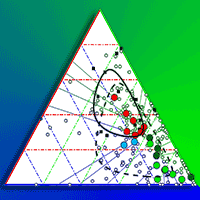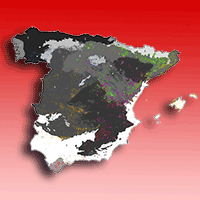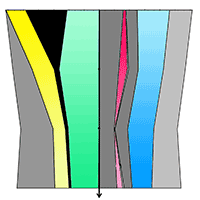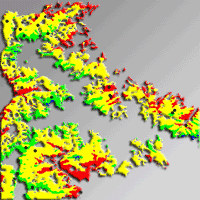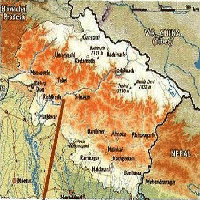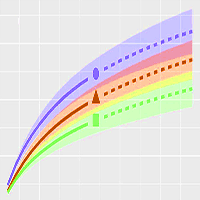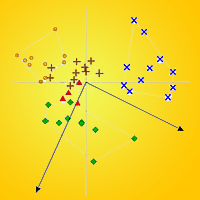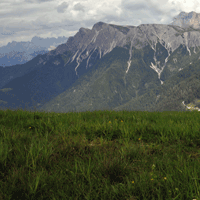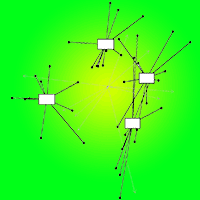
Assessing the habitat conservation status by soil parameters and plant ecoindicators
Flavia Sicuriello (1-2) , Cristina De Nicola (3), Giuseppina Dowgiallo (3), Anna Testi (3)
iForest - Biogeosciences and Forestry, Volume 7, Issue 3, Pages 170-177 (2014)
doi: https://doi.org/10.3832/ifor0963-007
Published: Feb 14, 2014 - Copyright © 2014 SISEF
Research Articles
Abstract
The aim of this study is to evaluate the conservation status of a Natural Reserve through an integrated approach analysing simultaneously soils, lithotypes, land forms, edaphic parameters and plant species. In focusing the relationships between soil and vegetation, plant ecoindicators, expressed by i) the Ellenberg bioindication model and by ii) the Hemeroby Index, and soil measured parameters were utilized.Vegetation and soil data have been collected simultaneously through thirty vegetation relevés and soil profiles. Cluster analysis, performed on matrix 12 variables/ 30 relevés allowed a division into two main clusters, each one divided into sub-clusters, distinguished by floristic composition and soil characteristics. The clusters were markedly discriminated by soil Available Water Capacity (AWC). Canonical Correspondence Analysis (CCA), performed on variables and species matrices, allowed to discriminate two main habitats: i) a core habitat represented by patches of temperate forest correlated to soil cycles of water and nutrients; ii) an ecotonal habitat shaped by mixed evergreen and thermophilous deciduous oak forest depending on light, temperature and human disturbance.
Keywords
Mediterranean Forest Vegetation, Soil, AWC, Ellenberg’s Indicators, Hemeroby Index, CCA
Authors’ Info
Authors’ address
Department of Forest Environment and Resources, University of Tuscia, v. S. Camillo de Lellis snc, I-01100 Viterbo (Italy)
IBAF-CNR, v. Salaria km 29.3, I-00016 Monterotondo Scalo (RM - Italy)
Giuseppina Dowgiallo
Anna Testi
Department of Environmental Biology, Botanical Garden, “La Sapienza” University of Rome, l.go Cristina di Svezia 24, I-00165 Rome (Italy)
Corresponding author
Paper Info
Citation
Sicuriello F, De Nicola C, Dowgiallo G, Testi A (2014). Assessing the habitat conservation status by soil parameters and plant ecoindicators. iForest 7: 170-177. - doi: 10.3832/ifor0963-007
Academic Editor
Raffaele Lafortezza
Paper history
Received: Feb 01, 2013
Accepted: Dec 03, 2013
First online: Feb 14, 2014
Publication Date: Jun 02, 2014
Publication Time: 2.43 months
Copyright Information
© SISEF - The Italian Society of Silviculture and Forest Ecology 2014
Open Access
This article is distributed under the terms of the Creative Commons Attribution-Non Commercial 4.0 International (https://creativecommons.org/licenses/by-nc/4.0/), which permits unrestricted use, distribution, and reproduction in any medium, provided you give appropriate credit to the original author(s) and the source, provide a link to the Creative Commons license, and indicate if changes were made.
Web Metrics
Breakdown by View Type
Article Usage
Total Article Views: 54549
(from publication date up to now)
Breakdown by View Type
HTML Page Views: 45304
Abstract Page Views: 2605
PDF Downloads: 4982
Citation/Reference Downloads: 17
XML Downloads: 1641
Web Metrics
Days since publication: 4321
Overall contacts: 54549
Avg. contacts per week: 88.37
Citation Metrics
Article Citations
Article citations are based on data periodically collected from the Clarivate Web of Science web site
(last update: Mar 2025)
Total number of cites (since 2014): 8
Average cites per year: 0.67
Publication Metrics
by Dimensions ©
Articles citing this article
List of the papers citing this article based on CrossRef Cited-by.
References
Guide geologiche nazionali: Lazio. Società Geologica Italiana, Roma, Italy, pp. 368. [in Italian]
Gscholar
Social behaviour types, the naturalness and relative ecological indicator values of the higher plants in the Hungarian flora. Acta Botanica Hungarica 39: 97-181.
Gscholar
Ellenbergs Zeigerwerte zur ökologischen Bewertung der archäologischen Zonen in Rom. Phytocoenologia 23: 291-299.
Gscholar
Linee guida dei metodi di rilevamento e informatizzazione dei dati pedologici. CRA-ABP, Firenze, Italy, pp. 282. [in Italian]
Gscholar
Mine soil morphology and properties in pre- and post-SMCRA coal mined landscapes in Southwest Virginia. In: Proceedings of the “National Meeting of the American Society of Mining and Reclamation”. Lexington (KY, USA) 18-24 April 2004. ASMR, Lexington, KY, USA, pp. 421-449.
Gscholar
Edaphic characteristics of mixed Quercus cerris communities in Latium. Annali di Botanica 51: 53-75.
Gscholar
Indicator values of vascular plants in Central Europe. Scripta Geobotanica 9: 1-122.
Gscholar
Zeigerwerte von Pflanzen in Mitteleuropa. Datenbank. Scripta Geobotanica 18: 1-258.
Gscholar
Invasive plants of the world. CABI Publishing, CAB International, Wallingford, UK, pp. 548.
Gscholar
Detecting large and fine scale patterns of disturbance in towns by means of plant species inventories: maps of hemeroby in the town of Rome - In: “Urbanization: 21st Century Issues and Challenges”. Nova Publisher, NY, USA, pp. 197-211.
Gscholar
Ecological indicator values for species in Central and Southern Italy flora. In: “Il Sistema Ambientale della Tenuta Presidenziale di Castelporziano. Ricerche sulla complessità di un ecosistema forestale costiero mediterraneo”. Accademia delle Scienze, “Scritti e Documenti” XXXVII, Seconda Serie, Vol. II, pp. 505-564. [in Italian]
Gscholar
Volcanically influenced speleogenesis: forming El Sistema Zacatón, Mexico, and Pozzo Merro, Italy, the deepest phreatic sinkholes in the world. Geological Society of America, Abstracts with Programs, pp. 35.
Gscholar
La Phytosociologie synusiale intégrée - Guide méthodologique. Docu. Labo. Ecol. Vég. Université de Neuchatel - Institut de Botanique 1, Neuchatel, Switzerland, pp. 68.
Gscholar
Pedologia forestale e conservazione del Suolo, Edizioni UTET, Torino, Italy, pp. 600. [in Italian]
Gscholar
Comparative plant ecology. Unwin-Hyman, London, UK, pp. 762.
Gscholar
Some responses of flora and vegetation to urbanization in Central Europe. In: “Urban ecology: plants and plant communities in urban environments” (Sukopp H, Hejny S, Kowarik I eds). SPB Academic Publishing, Amsterdam, the Netherlands, pp. 45-74.
Gscholar
Numerical ecology (2nd edn). Elsevier Science BV, Amsterdam, The Netherlands, pp. 880.
Gscholar
Sguardo sulla vegetazione del Lazio Marittimo. Quaderni Accademia Nazionale dei Lincei 264: 5-48. [in Italian]
Gscholar
L’evoluzione della dorsale tiberina (Lazio centrale). Rendiconti Lincei 3 (2): 97-107. [in Italian]
Gscholar
Metodi di analisi chimica del suolo. Ministero delle Politiche Agricole e Forestali, Franco Angeli Editore, Rome, Italy, pp. 536. [in Italian]
Gscholar
Landcape ecology, management and conservation of European and Levant Mediterranean uplands. In: “Functional analysis in Mediterranean ecosystems” (Tenhunen JD, Catarino FM, Lange OL, Oechel WC eds). Springer, Berlin, Germany, pp. 641-657.
Gscholar
Biondicazione attraverso le piante vascolari. Valori di indicazione secondo Ellenberg (Zeigerwerte) per le specie della Flora d’Italia. Braun-Blanquetia 39: 1-97. [in Italian]
Gscholar
Reliability and effectiveness of Ellenberg’s indices in checking flora and vegetation changes induced by climatic variations. In: “Fingerprints of climate changes: adapted behaviour and shifting species ranges” (Walter JR, Burga CA, Edwards PJ eds). Kluwer Academic Publishing, New York, USA and Plenum Publisher, London, UK, pp. 281-304.
Gscholar
Analisi ed esplorazione multivariata dei dati in ecologia e biologia. Liguori Editore srl, Naples, Italy, pp. 544. [in Italian]
Gscholar
Phytosociological typology and bioindicator values of plant communities, as exemplified by meadows in the Nina valley, Southern Poland. Documents Phytosociologiques 11: 543-554.
Gscholar
Floristic and phytogeographical diversity in some protected areas in Italy. Ecologia Mediterranea 22 (3-4): 81-100.
Gscholar
La riserva naturale “Macchia di Gattaceca e Macchia del Barco” nel Lazio: un’importante area forestale di contatto tra la vegetazione mediterranea e balcanica. Linea Ecologica 6: 35-42. [in Italian]
Gscholar
Soil water availability as a discriminant factor in forest vegetation: preliminary results on sub-coastal mixed oak woodlands in central-southern Latium (Central Italy). Annali di Botanica 4: 49-64.
Gscholar
An example of realization of Gis ecological maps derived from Ellenberg indicator values in the Biological Reserve of Donana National Park (Spain). Rendiconti Accademia dei Lincei 9: 1-17.
Gscholar
Man-made natural ecosysems in environmental management and planning. In: “Unifying concepts in ecology” (van Dobben WH, McConnel L eds). Junk, The Hague, Pudoc, Wageningen, The Netherlands, pp. 263-274.
Gscholar
On the use of ecological factor numbers in Norwegian forest communities. Norske Videnskap Selskovo Rapport Botaniska Serie 5: 178-201. [in Norwegian]
Gscholar
The Braun-Blanquet approach. In: “Classification of plant communities” (Whittaker RH ed). Junk, The Hague, The Netherlands, pp. 287-399.
Gscholar
Quercus ilex L. litter decomposition and mineral evolution in an evergreen oak woodland in Majorca (Balearic islands, Spain). In. “Responses of forest ecosystems to environmental changes” (Teller A, Mathy P, Jeffers JNR eds). Elsevier Sciences Publishers Ltd., Oxford, UK, pp. 865-866.
Gscholar

